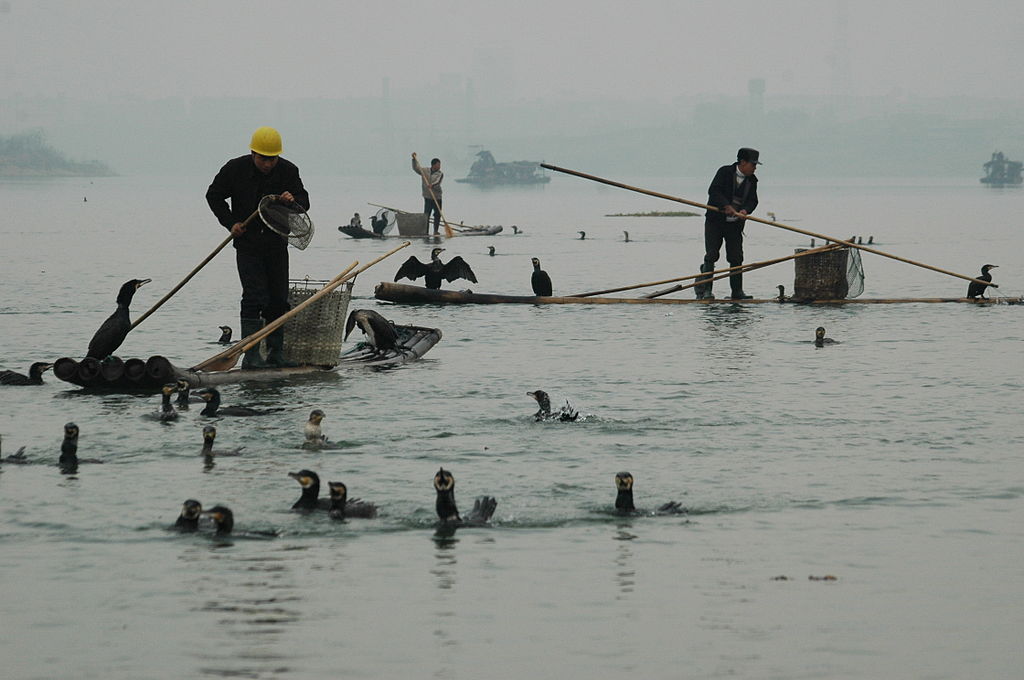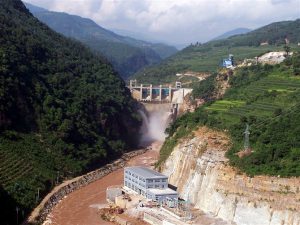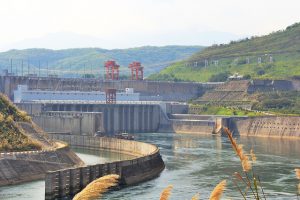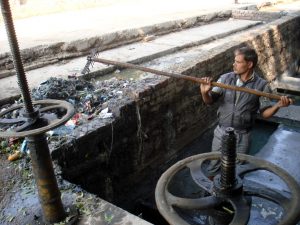Last November, Jiangxi, a province in central China on the Yangtze River, unexpectedly announced that an environmental impact assessment was underway for a dam project between Poyang Lake and the Yangtze with an estimated cost of 13 billion yuan (US$188 million).
It looked like the barrier between China’s largest freshwater lake and its largest river, discussed and delayed for two decades, might finally become a reality.
The project is strongly opposed by some experts and environmental groups. Over 100 organisations, including the China Biodiversity and Conservation and Green Development Foundation and the Let Migratory Birds Fly Foundation, have signed a joint letter opposing the idea.
Although Poyang Lake is known as China’s largest freshwater lake, it actually has no fixed size. The lake is broad and shallow and has sharp seasonal variations in depth because of its connection to the Yangtze. In the drier autumn and winter months when more water flows into the river, the lake’s water level drops more than ten metres and its area shrinks from over 3,000 square kilometres to just 100 square kilometres. Because of this, Jiangxi’s waterways are described as a vast expanse in the wet season, but a mere river in the dry season.
In an effort to explain why the project is necessary, the office in charge of the lake’s water management system pointed out that over the past decade it has experienced earlier and lengthier dry periods, with water levels reaching record lows in some years. In these circumstances, the water supply for agriculture and for use in nearby cities is cut off. In theory the dam would allow authorities to create a reservoir and better regulate the water supply in times of drought.
Guo Weiqing, a professor studying water conflicts and regional politics at Sun Yat-sen University, said that authorities in Jiangxi have been working on plans to dam the lake since the 1990s.
In December 2009, environmental and economic development plans for Poyang Lake were approved by the State Council, including: “Researching and when appropriate progressing the construction of a water management hub at Poyang Lake.” However, efforts to prevent the lake from drying up were to be considered separately from the overall plan.
Poyang Lake and the Three Gorges
Alongside climate change, another factor contributing to low water levels in the lake is ongoing hydropower development on the Yangtze, particularly the world’s biggest hydropower facility, the Three Gorges Dam.
To ensure the Three Gorges holds enough water for power generation and to supply downstream regions through the dry season, water is retained there after the flood season.
Fan Xiao, hydrologist and chief engineer with the Sichuan Geological Bureau’s regional survey team, told chinadialogue that when the Three Gorges retains water between September and November, downstream flows are much lower than usual. This means that large volumes of water flow out of both Poyang Lake and Dongting Lake in neighbouring Hunan province.
As far back as 2011, Zhu Laiyou, at the time deputy head of the provincial water authority, told the media that “retention of water in upstream reservoirs, such as the Three Gorges, has resulted in major changes to available water downstream during the dry season, to the detriment of water resources downstream and in the Poyang Lake area.”
The Jiusan Society, a political party made up primarily of senior intellectuals, backed up Fan Xiao’s analysis in an article published in December 2016. It said downstream flows in summer and autumn had diminished since the filling of the Three Gorges reservoir and that as water levels in the Yangtze determine the size of Poyang Lake, the filling of upstream reservoirs is the root cause of the extended dry periods.
Fighting dams with dams
The Jiangxi water authority argues that intervention is necessary because the Yangtze is no longer a natural river and that problems caused by engineering projects must now be resolved with further engineering.
Nanchang University professor and former deputy governor of Jiangxi, Hu Zhenpeng is one of the main advocates for the dam. He told Science and Technology Daily that three options have been examined and that the dam offers the greatest benefits.
“We wouldn’t be building it if there was a better solution,” said Hu.
Zhou Jianjun, a professor at the Department of Hydraulic Engineering at Tsinghua University, as well as the Jiusan Society have recommended using groundwater to supplement water supplies in the dry season.
But Hu thinks that is unrealistic: “Levels of iron and manganese in the groundwater near Poyang Lake are too high and there’s no economic or practical way of removing those, so the water can’t be brought up to standard for consumption.”
Hu told thepaper.cn that current proposals would see the dam used to retain water only for around 100 days a year (between November and February), and there would be no power generation facility. During the April to August flood season the gate would be open leaving the lake and river connected, and that over the course of a year the lake’s inflows and outflows would be kept in balance, he said.
Hu stressed that the project has taken fish populations into account, by adding a channel to allow migratory fish to pass; including the endangered finless porpoise, of which only 1,000 are left.
But not everyone agrees. Li Jianhua, a professor at Tongji University’s College of Environmental Science and Engineering, said in an interview that Jiangxi’s plans are an artificial intervention in natural water systems that uses the “Three Gorges method” to solve problems caused by the Three Gorges.
chinadialogue submitted questions about the effects of the dam and the changes to water levels in the dry season to the office in charge of the project, but no response had been received as of the time of writing.
Ecological risks
Other opponents of the scheme are concerned about irreversible ecological damage.
Poyang Lake is a globally important wetland. According to WWF China, which said in November that it was observing the situation closely, Poyang Lake is the largest winter refuge for migrating birds in East Asia and a habitat for the largest surviving population of the finless porpoise.
The value of Poyang Lake stems from its naturally fluctuating water levels and its connection with the Yangtze; an irreplaceable part of the global ecosystem.
Environmental experts have similar worries. They fear that the dam will cut the lake off from the river, and that a few channels will not be enough to ensure migratory fish return to breed, and that higher water levels in the dry season will inundate the habitats of wetland birds.
“Building a dam is just making another mistake to try and correct other mistakes,” said Fan Xiao. He argues the project will permanently destroy the natural link between the lake and the river.
But Jiangxi has indicated it is willing to defend the project against challenge. On December 7, Science and Technology Daily reported that the provincial authorities are ready for the environmental impact assessment to be subjected to intense scrutiny.
Water conflicts
Another concern is that the project will set a precedent that other regions will follow, resulting in conflicts over water resources.
Zhou Jianjun said at a recent seminar on protecting the lake that it is the source of 16% of the Yangtze’s total water supply. If all the lakes and tributaries on the Yangtze are controlled, conflicts over water will arise during times of environmental stress. A dam on the lake may set a precedent that will be followed at Dongting Lake.
But Hu Zhenpeng argues that all river lakes are managed to some extent. “Although there are no dams at Poyang or Dongting, there are many dams and sluice gates elsewhere on the Yangtze; why can’t there be one at Poyang? The question is why and how should it be managed,” he said.
Hu also revealed that Jiangxi has held talks with local governments downstream, addressing concerns held in places such as Anhui, Jiangsu and Shanghai.
“They don’t object to the construction [of the dam] but they want it to be managed by the Yangtze River Commission [rather than the Jiangxi local government],”said Hu.
Water conflict expert professor Guo said that preserving Poyang Lake is important for the entire Yangtze downstream and that the construction of a dam will disrupt the natural allocation of water resources, which could cause regional conflict in the long term. To prevent disputes happening, negotiations will need to be open and transparent.
Friends of Nature, China’s oldest environmental group said on its website that it hopes to see hearings attended by environmental experts, social scientists and civil society groups. It called for the Jiangxi government to publish earlier research on Poyang Lake engineering projects. The group also called for government to act cautiously and with the entire Yangtze watershed in mind.
According to Guo, an environmental impact assessment for Poyang Lake is inadequate; the environmental impact on the entire region must be examined.









